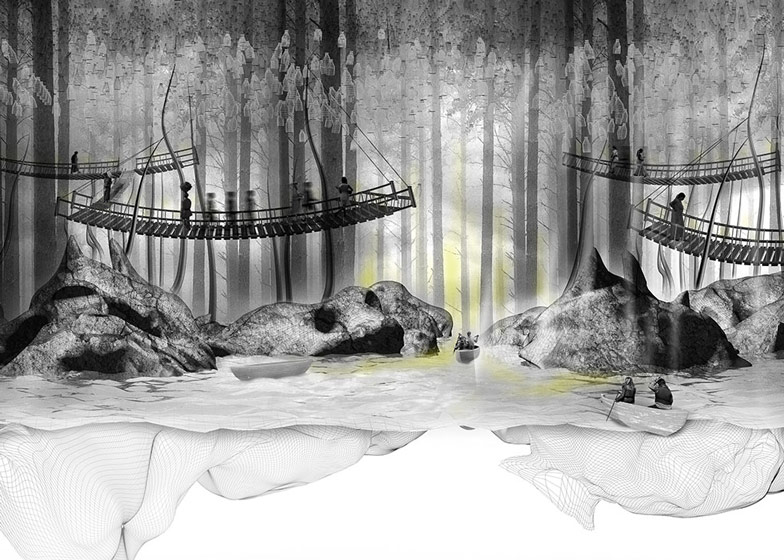The disputed territory of the Kashmir Valley becomes a fantasy realm for children, where story-telling pavilions are accompanied by dragons and jinns, in this project by Bartlett architecture graduate Haaris Ramzan (+ slideshow).
Bordering both India and Pakistan, the valley has been the cause of conflict between the two nations for over 60 years, so Ramzan wanted to develop a conceptual architecture for the many children that have been left orphaned as a result.
"This project is about the contrast between what is essentially a beautiful landscape and a gritty political conflict," he told Dezeen.
"I wondered if there was a way I could propose an architecture that would transcend that."
The brief was to design a guild that preserves a traditional craft, so the Guild of the Story-Teller is designed as a dedicated place for telling and creating Kashmiri fairytales.
"The art of storytelling was starting to become a forgotten heritage and forgotten cultural act," said Ramzan. "I saw storytelling as something that the orphans could utilise, that would also revive a forgotten art."
Ramzan has imagined five pavilions, each based on the physical forms of animals and other creatures that recur in Kashmiri tales.
The scaly wings of a dragon create a mountain of tents for compiling stories inside, while the horns of jinns – supernatural beings said to be made of fire – rise up from a lake to create a place for hanging water bottles used for the storyteller's writing ink.
Other structures include an auditorium inside the shell of a turtle, an archive where book pages mimic the feathers of a phoenix, and a lion's den where tree leaves are burnt to make ink.
Ramzan also added details from typical Kashmiri buildings, spaces and objects, such as the paving stones and fabric patterns.
"For me it was a case of taking the physical language of these animals and applying it to the pavilions themselves, but also looking at Kashmiri vernacular and ornament, and how it can ground the architecture," he explained.
Guild of the Story-Teller was Ramzan's graduate project from the Bartlett's Unit 18, entitled Carving a Giant, which asks students to consider the social spaces and cultural narratives of architecture.
Read on for a project description from Haaris Ramzan:
Guild of the Story-Teller
The Realm of the Story-teller is a fairy-tale retreat situated on the Dal Lake, Kashmir. The Kashmir Valley resides along the line of control between India and Pakistan and has long been a flashpoint for the dispute over the ownership of Kashmir between these two nations. One of the unfortunate outcomes of this conflict is the rise in the number of orphans within the valley and a struggling infrastructure to accommodate for their emotional and psychological needs. The purpose of the retreat is to provide the orphans of Kashmir with a moment of escape from the turbulence of the conflict they are exposed to within the valley, and provoke an imaginary realm of fantasy and adventure through the forgotten art of story-telling.
The realm is composed of five key pavilions which facilitate for the process of writing, reading and archiving fairy-tales. The transition through these spaces follows the relationship between the story-teller and the orphans of Kashmir. The architectural language of the realm attempts to embody a dual perspective, in which from the perspective of the child the space is experienced in one way and by the story-teller in another. The realm is anchored to the context of the valley through utilising details of traditional Kashmiri ornament or specific cultural events that occur within the valley. The architectural language of each pavilion mimics that of the menagerie of animals and beasts found within traditional Kashmiri fairy-tales.
1. The Jinn forest
The Jinn forest is the threshold between the real world and the fantasy realm. The beginning of the story-telling journey for the children in which the horns of the Jinn heads which are submerged into the lake extrude to simulate the trees of a forest. From these trees hangs the bottles used to collect water for ink by the story-teller.
2. The Lion's Den
The lion's den is the space in which the leaves of the chinar tree are collected and burned to mix with the bottled water to make the ink for the fairy-tales. The voids in which the leaves are burned mimic the teeth of the lion and the space is encased in a swirling render which mimics the mane of the lion.
3. The Dragon's Wing
The dragon's wing forms an armoured mountain of tents which mimic the Himalayan mountains which surround the valley and forms an intimate collection of spaces in which the children and the teller begin to craft their own pages of the fairy-tale.
4. The Turtle's Shell
The turtle shell acts as the auditorium in which the compiled fairy-tale is read to the children by the story-teller. The shell is ornamented in the traditional Kashmiri pattern which perforates the skin of the shell.
5. The Phoenix Nest
The phoenix nest signifies the end of the journey in which the fairy-tale books are archived in an outpost. The books form the skin of the outpost and mimic the feather of the phoenix. The children reclaim their pages of the story by ripping them from the facade, and running them as kites. Kite running being a popular cultural event within the Valley of Kashmir.










